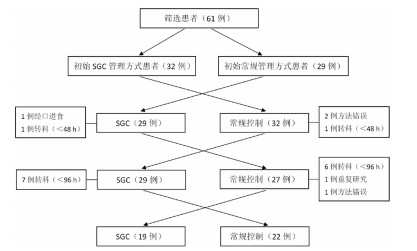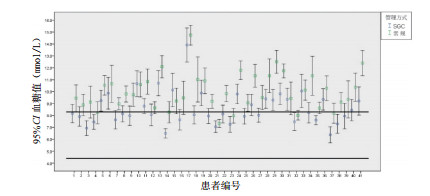重症患者的应激性高血糖的控制已逐渐受到重视。重症脓毒症伴有应激性高血糖患者,接受强化胰岛素治疗严格控制血糖,能更有效抑制炎症因子[1]。同时,有研究表明,精准血糖控制可有效防止脑卒中相关感染患者血糖波动,提高T淋巴细胞免疫功能,降低脑卒中相关感染的发生率,从而改善预后[2]。适集思血糖控制(space glucose control, SGC)技术是精准控制血糖的一种新型方式,在国外不断推广,以期达到稳定动态地控制血糖。研究表明[3-6],SGC对患者的高血糖及血糖水平的稳定性控制良好。但是,目前SGC在国内的实施与研究仍较少,其安全性和可行性尚有待进一步确定。如何能尽早将血糖维持在治疗目标范围内,并防止严重低血糖和高血糖的发生,是ICU患者血糖管理质量的重要内容。
因此,本研究通过对ICU应激性高血糖患者实施SGC与常规控制方案两种血糖管理方法,分析比较两者在血糖控制效果上的优劣,试图为ICU患者血糖控制方法的选择提供临床依据。
1 资料与方法 1.1 伦理认证本研究经苏州大学附属第二医院伦理委员会认证,为临床患者血糖常规监测范围,在苏州大学附属第二医院重症监护室进行,临床试验注册号:JD-LK-2018-065-02。
1.2 研究对象与分组本研究治疗及检测均获得患者或家属的知情同意。采取前瞻性交叉对照的类试验研究的方法,入选患者每24 h两组互换交叉,即每个患者应用SGC或常规血糖管理均进行24 h后交替,试验终点为96 h。入选标准:发生应激性高血糖且至少有一次血糖≥10.0 mmol/L并需进行静脉输注胰岛素进行治疗者,年龄≥18岁,预计入住ICU时间≥96 h的患者。排除标准:酮症酸中毒; 非酮症高渗性昏迷; 孕妇; 胰岛素过敏者; 濒死或24 h内可能死亡的患者,入选流程见图 1。

|
| 图 1 患者入选流程图 Fig 1 Patient enrollment flow chart |
|
|
SGC方案[4]:①测定患者末梢血糖; ②将血糖值输入血糖模块,通过对患者血糖进行系统分析后,模块自动调控并确定输注胰岛素剂量; ③通过系统分析下一次血糖监测时间并通过声控报警提醒。
常规方案:①由医生制定胰岛素治疗方案; ②由护士测定患者末梢血糖,根据胰岛素治疗方案个性化量表输入胰岛素剂量; ③根据医嘱确定首次末梢血糖值在8~10 mmol/L之间,每2 h测血糖; 首次末梢血糖值≤6.0 mmol/L,每1 h测血糖; 首次末梢血糖值≤4.0 mmol/L,每30 min测血糖,并予以50%葡萄糖溶液20 mL静脉注射; 首次末梢血糖值≥10.0 mmol/L,每1 h测血糖,并予以胰岛素治疗。若连续4次血糖值均不在目标范围内,汇报医生并调整治疗方案。
所有患者均采用相同血糖仪(Optium Xceed, USA)进行末梢血糖测定,采用50 mL注射器,应用40 U胰岛素加入39 mL 0.9%氯化钠溶液中进行标准化药物配制。
1.3 主要观察指标和血糖达标标准值SGC内置目标血糖范围4.4~8.3 mmol/L[5]。本研究监测的指标包括平均血糖值、血糖最高值、血糖最低值、高血糖次数(> 8.3 mmol/L)、低血糖次数(< 4.4 mmol/L)、目标血糖(4.4~8.3 mmol/L)频次、轻度低血糖(3.4~4.3 mmol/L)次数、中度低血糖(2.2~3.3 mmol/L)次数、严重低血糖(< 2.2 mmol/L)次数、平均血糖检测间隔时间和累积胰岛素用量。
1.4 统计学方法采用SPSS 23.0进行统计分析,计数资料采取频数(率)的方式表达,两组间比较采取卡方检验。计量资料根据数据分布情况,符合正态分布的资料,用均数±标准差(Mean±SD)表示,采用成组t检验; 不符合正态分布的资料,以中位数(最小值,最大值)表示,采用非参数秩和检验。以P < 0.05为差异有统计学意义。
2 结果 2.1 两组患者的一般资料2018年1月至2019年1月期间,共有61例高血糖患者进入了本研究,最终41例患者完成试验(图 1)。比较初次进入不同血糖管理两组患者的年龄、性别、入院诊断、体质量指数(BMI)、糖尿病史及APACHEⅡ等基线情况,Fisher精确检验结果显示均差异无统计学意义(P > 0.05),见表 1。
| 指标 | 例数 | 初始SGC组 (n=22) |
初始常规组 (n=19) |
P值 |
| 年龄(岁) | 1.000 | |||
| ≤55 | 14 | 7(31.8) | 7(36.8) | |
| 56~75 | 18 | 10(45.5) | 8(42.1) | |
| ≥76 | 9 | 5(22.7) | 4(21.1) | |
| 性别 | 0.524 | |||
| 男 | 28 | 14(63.6) | 14(73.7) | |
| 女 | 13 | 8(36.4) | 5(26.3) | |
| BMI(kg/m2) | 1.000 | |||
| < 18.5 | 3 | 2(9.1) | 1(5.3) | |
| 18.5~23.9 | 22 | 11(50.0) | 11(57.9) | |
| 24~28 | 13 | 7(31.8) | 6(31.6) | |
| > 28 | 3 | 2(9.1) | 1(5.3) | |
| 既往糖尿病史 | 0.313 | |||
| 有 | 13 | 5(22.7) | 8(42.1) | |
| 无 | 28 | 17(77.3) | 11(57.9) | |
| 主要疾病诊断 | 0.648 | |||
| 消化系统 | 14 | 7(31.8) | 7(36.8) | |
| 呼吸系统 | 10 | 7(31.8) | 3(15.8) | |
| 多发伤 | 8 | 5(22.7) | 3(15.8) | |
| 神经系统 | 6 | 2(9.1) | 4(21.1) | |
| 循环系统 | 2 | 1(4.5) | 1(5.3) | |
| 内分泌系统 | 1 | 0(0.0) | 1(5.3) | |
| APACHEⅡ | 0.926 | |||
| < 15 | 11 | 6(27.3) | 5(26.3) | |
| 15~24 | 14 | 8(36.4) | 6(31.6) | |
| > 24 | 16 | 8(36.4) | 8(42.1) |
与常规方式相比,SGC方式患者的血糖均数基本处于目标血糖的范围内,且差异有统计学意义(P < 0.01)。SGC方式高血糖(> 8.3 mmol/L)发生次数明显少于常规组(P < 0.05)。见表 2。
| 指标 | SGC组 | 常规组 | 统计值 | P值 |
| 血糖平均数(mmol/L) | 8.60±1.42 | 10.02±1.49 | -9.174 | < 0.01 |
| 血糖最高值(mmol/L) | 14.60±3.75 | 15.25±3.34 | -1.245 | 0.220 |
| 高血糖次数 (> 8.3 mmol/L) |
16.59±8.56 | 18.73±7.91 | -2.368 | 0.023 |
| 目标血糖频次 | 53.07±19.11 | 29.44±19.60 | 10.367 | < 0.01 |
与常规方式相比,SGC方式低血糖(< 4.4 mmol/L)与轻度低血糖(3.4~4.3 mmol/L)发生次数明显高于常规方式(P < 0.05);但是,SGC方式未发现有严重低血糖(< 2.2 mmol/L)发生,而常规方式有1次严重低血糖发生。另外,常规血糖管理方式血糖监测频次,累积胰岛素用量均明显低于SGC方式(P < 0.01或P < 0.05)。见表 3。
| 指标 | SGC组 | 常规组 | t/Z值 | P值 |
| 血糖最低值(mmol/L)a | 4.25±0.85 | 5.74±1.68 | -6.140 | < 0.01 |
| 低血糖次数 (< 4.4 mmol/L)b |
1(0, 5) | 0(0, 2) | -3.332 | < 0.01 |
| 3.4~4.3 mmol/L次数b | 0(0, 3) | 0(0, 1) | -3.617 | < 0.01 |
| 2.2~3.3 mmol/L次数b | 0(0, 2) | 0(0, 1) | -1.508 | 0.132 |
| < 2.2 mmol/L次数b | 0(0, 0) | 0(0, 1) | -1.000 | 0.317 |
| 平均血糖检测间隔时间(h)a | 1.36±0.23 | 1.89±0.28 | -12.254 | < 0.01 |
| 累积胰岛素用量(U)a | 139.61±77.06 | 107.49±64.41 | 4.189 | < 0.01 |
| 注:a为Mean±SD; b为M(最小值,最大值) | ||||
观察每位患者在SGC和常规血糖管理下血糖均数的变化发现,SGC方式更容易使患者血糖值控制在目标范围内,而常规方式管理血糖只有2例患者的平均血糖值控制在目标值范围。见图 2。

|
| 图 2 SGC与常规血糖管理方式对患者平均血糖影响的比较 Fig 2 Comparison of average blood glucose between the two groups |
|
|
高血糖、低血糖和血糖变异性均与ICU患者并发症的发生率和病死率相关[7]。ICU患者入院时血糖水平与死亡风险呈显著正相关,急性高血糖或低血糖的发生均可增加ICU患者的病死率[8-9]。故此,血糖管理是ICU患者基础治疗的重要内容。
随着血糖管理临床研究与应用的深入,近几年智能化血糖管理已得到快速发展。SGC是一种新型控制血糖的方法,包括两个输液泵[肠内和(或)肠外营养],一个推注泵(胰岛素泵)和一个内置eMPC[10]模块组成。在增强型预测控制模型的基础上,通过参数运算获得公式,在对患者血糖进行系统分析后,生成胰岛素使用剂量并自主调控胰岛素剂量的智能系统,以期动态控制血糖在预定的范围内。
2012和2014年国外两项多中心随机对照研究,显示了SGC在血糖管理中的优势[5, 11]。此后,国内Xu等[6]也进行了单中心随机对照研究,结果表明SGC在血糖控制效果方面优于常规血糖管理。但是,SGC是否增加护士工作量,以及安全性等问题尚需进一步探讨研究。本研究设定目标血糖值范围为4.4~8.3 mmol/L,与常规血糖管理方式相比,SGC血糖管理方式对患者高血糖的控制效果更好,但一定程度上增加了医护人员的工作量。
与常规血糖管理方式相比,通过观察血糖在目标血糖范围内的频次、血糖平均数、血糖最高值(表 2)和血糖最低值等指标(表 3),发现SGC在管理ICU患者应激性高血糖方面能更快降低血糖,且更易控制血糖在目标范围(图 2),体现了SGC在高血糖患者血糖管理上的优势,这与国内外的研究[4-6, 12]结果一致。
本研究中SGC管理方式共发生低血糖39次,其中轻度低血糖31次,中度低血糖8次,但没有严重低血糖的发生; 而常规管理方式共发生低血糖9次,其中轻度低血糖5次,中度低血糖3次,严重低血糖1次。统计分析结果显示,只有轻度低血糖的发生率两种方式差异有统计学意义。表明应用SGC进行血糖管理容易导致轻度低血糖的发生。分析SGC管理方式低血糖发生的原因,发现2次是因为在应用营养液时由于治疗的需要另接一路灭菌用水进行营养液的稀释时,而SGC系统无法识别营养液的稀释度,导致泵入的营养液减少而胰岛素泵入量却并未下降,最终导致低血糖的发生。已有研究指出,要达到预设置较低的目标血糖值范围,而又不增加低血糖发生的风险是比较困难的[12-15]。
本研究中,SGC管理方式血糖监测平均间隔时间短于常规管理方式,累积胰岛素用量SGC远高于常规管理方式,且差异有统计学意义(P < 0.05),表明应用SGC进行血糖管理会增加护理人员的工作量,但是会更加精确地做到随时监测患者由于营养或其他治疗所致的血糖变化,以维持血糖的平稳,避免血糖忽高忽低影响患者病情。此结果与国内外进行的SGC或eMPC进行的临床研究结果一致[3-6, 11]。
SGC已在国外ICU得以应用[4],但由于相关数据报道的有限性,缺乏足够的证据说明应用SGC控制ICU患者应激性高血糖对其预后的影响。有相关研究指出,严格控制血糖对于患者的预后影响存在着较大的争议[6, 16-17]; 但关于SGC对血糖的管理已有多个研究证明其安全性、可靠性和有效性[4-6, 11]。国外两个多中心研究指出院内病死率分别为20%和30%[5, 11],但国内研究未见有相关报道,本研究也尚未涉及预后相关问题。
本研究的局限性:①采取前瞻性交叉对照的类试验研究方法,单中心研究且未达到随机; ②因SGC模块数量的限制,样本量较少; ③本研究所定目标血糖范围是依据SGC血糖管理内置血糖目标范围值(4.4~8.3 mmol/L),是否适合国内人群的血糖控制目标有待于进一步研究。
综上所述,SGC方式具有对高血糖控制的有效性与保持血糖稳定性的优点。但是,存在增加护理工作量与低血糖风险的问题。持续使用SGC对于血糖控制质量与患者预后关系的影响尚待进一步研究。
| [1] | 柳学, 林晓军, 何楷然, 等. 重症脓毒症患者血糖控制与炎症因子变化及临床意义[J]. 中华急诊医学杂志, 2017, 26(12): 1438-1441. DOI:10.3760/cma.j.issn.1671-0282.2017.12.021 |
| [2] | 王雁, 阿迪力·阿不都热合曼, 王烁, 等. 精准血糖控制对脑卒中相关感染免疫功能的影响[J]. 中华急诊医学杂志, 2017, 26(4): 381-385. DOI:10.3760/cma.j.issn.1671-0282.2017.04.005 |
| [3] | Amrein K, Ellmerer M, Hovorka R, et al. Hospital glucose control: safe and reliable glycemic control using enhanced model predictive control algorithm in medical intensive care unit patients[J]. Diabetes Technol Ther, 2010, 12(5): 405-412. DOI:10.1089/dia.2009.0147 |
| [4] | Blaha J, Barteczko-Grajek B, Berezowicz P, et al. Space Glucose Control system for blood glucose control in intensive care patients - a European multicentre observational study[J]. BMC Anesthesiol, 2015, 16: 8. DOI:10.1186/s12871-016-0175-4 |
| [5] | Amrein K, Ellmerer M, Hovorka R, et al. Efficacy and safety of glucose control with space glucose control in the medical intensive care unit: an open clinical investigation[J]. Diabetes Technol Ther, 2012, 14(8): 690-695. DOI:10.1089/dia.2012.0021 |
| [6] | Xu B, Jiang W, Wang CY, et al. Comparison of space glucose control and routine glucose management protocol for glycemic control in critically ill patients: a prospective, randomized clinical study[J]. Chin Med J, 2017, 130(17): 2041-2049. DOI:10.4103/0366-6999.213422 |
| [7] | Gunst J, van den Berghe G. Blood glucose control in the ICU: how tight?[J]. Ann Transl Med, 2017, 5(4): 76. DOI:10.21037/atm.2017.01.45 |
| [8] | Mahmoodpoor A, Hamishehkar H, Shadvar K, et al. Relationship between glycated hemoglobin, Intensive Care Unit admission blood sugar and glucose control with ICU mortality in critically ill patients[J]. Indian J Crit Care Med, 2016, 20(2): 67-71. DOI:10.4103/0972-5229.175938 |
| [9] | Sechterberger MK, Bosman RJ, Oudemans-van Straaten HM, et al. The effect of diabetes mellitus on the association between measures of glycaemic control and ICU mortality: a retrospective cohort study[J]. Crit Care, 2013, 17(2): R52. DOI:10.1186/cc12572 |
| [10] | Kulnik R, Plank J, Pachler C, et al. Evaluation of implementation of a fully automated algorithm (enhanced model predictive control) in an interacting infusion pump system for establishment of tight glycemic control in medical intensive care unit patients[J]. J Diabetes Sci Technol, 2008, 2(6): 963-970. DOI:10.1177/193229680800200606 |
| [11] | Amrein K, Kachel N, Fries H, et al. Glucose control in intensive care: usability, efficacy and safety of Space GlucoseControl in two medical European intensive care units[J]. BMC Endocr Disord, 2014, 14: 62. DOI:10.1186/1472-6823-14-62 |
| [12] | Preiser JC, Brunkhorst F. Tight glucose control and hypoglycemia[J]. Crit Care Med, 2008, 36(4): 1391. DOI:10.1097/ccm.0b013e31816a16d0 |
| [13] | Brunkhorst FM, Engel C, Bloos F, et al. Intensive insulin therapy and pentastarch resuscitation in severe sepsis[J]. N Engl J Med, 2008, 358(2): 125-139. DOI:10.1056/nejmoa070716 |
| [14] | NICE-SUGAR Study Investigators, Finfer S, Chittock DR, Su SY, et al. Intensive versus conventional glucose control in critically ill patients[J]. N Engl J Med, 2009, 360(13): 1283-1297. DOI:10.1056/nejmoa0810625 |
| [15] | de la Rosa GD, Donado JH, Restrepo AH, et al. Strict glycemic control in patients hospitalized in a mixed medical and surgical intensive care unit: a randomized clinical trial[J]. Crit Care, 2008, 12(5): R120. DOI:10.1186/cc7017 |
| [16] | van den Berghe G, Wouters P, Weekers F, et al. Intensive insulin therapy in critically ill patients[J]. N Engl J Med, 2001, 345(19): 1359-1367. DOI:10.1056/nejmoa011300 |
| [17] | van den Berghe G, Wilmer A, Hermans G, et al. Intensive Insulin Therapy in the Medical ICU[J]. N Engl J Med, 2006, 354(5): 449-461. DOI:10.1056/nejmoa052521 |
 2019, Vol. 28
2019, Vol. 28




